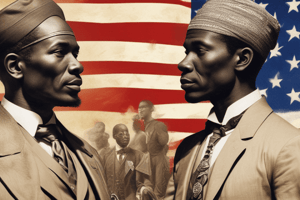Podcast
Questions and Answers
What was a primary goal of Reconstruction after the Civil War?
What was a primary goal of Reconstruction after the Civil War?
- To rebuild the South and integrate freed African Americans into society (correct)
- To limit the powers of the federal government
- To expand the U.S. territory westward
- To establish a new political party in the South
Which amendment is primarily associated with granting citizenship to African Americans?
Which amendment is primarily associated with granting citizenship to African Americans?
- Nineteenth Amendment
- Fourteenth Amendment (correct)
- Thirteenth Amendment
- Fifteenth Amendment
What factor contributed to Congress taking control of Reconstruction?
What factor contributed to Congress taking control of Reconstruction?
- The demand for immediate civil rights by freed African Americans
- The widespread approval of Reconstruction policies by the Southern states
- The resurgence of pre-war southern leadership (correct)
- The strong support of President Johnson
What organization emerged during Reconstruction that sought to maintain white supremacy?
What organization emerged during Reconstruction that sought to maintain white supremacy?
Which event marked the official end of Reconstruction?
Which event marked the official end of Reconstruction?
What was a key outcome of President Johnson's Reconstruction Plan?
What was a key outcome of President Johnson's Reconstruction Plan?
Which amendment granted African American men the right to vote?
Which amendment granted African American men the right to vote?
What was one of the primary hurdles faced by African Americans after Reconstruction?
What was one of the primary hurdles faced by African Americans after Reconstruction?
Which group sought to restore pre-war Southern leadership during Reconstruction?
Which group sought to restore pre-war Southern leadership during Reconstruction?
What significant role did Congress play in Reconstruction?
What significant role did Congress play in Reconstruction?
Flashcards are hidden until you start studying
Study Notes
Reconstruction Overview
- Aimed to address the challenges of reuniting the nation after the Civil War.
- Focused on rebuilding the Southern economy and integrating formerly enslaved individuals into society.
Rebuilding the South
- Reconstruction marked the beginning of significant changes in Southern society.
- Problems arose from economic devastation, infrastructure destruction, and societal shifts.
Freedom for African Americans
- Emancipation led to legal freedom, but true equality remained elusive.
- Newly freed African Americans sought to establish families, own land, and gain education.
President Johnson's Reconstruction Plan
- Proposed a lenient approach, allowing Southern states to rejoin with minimal conditions.
- Required states to renounce secession and accept the Thirteenth Amendment.
Opposition to President Johnson
- Johnson faced resistance from Radical Republicans who sought more stringent measures.
- Conflict over leadership and direction of Reconstruction policies escalated.
Fourteenth Amendment
- Ratified in 1868, granting citizenship and equal protection under the law to all persons born in the U.S.
- Aimed to safeguard the rights of African Americans and curb state discrimination.
Congress Takes Control of Reconstruction
- Congress, driven by Radical Republicans, took charge after Johnson's policies faltered.
- Implemented military district governance in the South to enforce new laws and protect civil rights.
Fifteenth Amendment
- Ratified in 1870, prohibited denying the right to vote based on race, color, or previous condition of servitude.
- Empowered African American men politically but led to resistance and backlash in many Southern states.
Reconstruction Governments
- Southern state governments included African Americans in political positions.
- These governments faced hostility and were often undermined by violence and intimidation.
Ku Klux Klan
- Formed in the aftermath of the Civil War, aimed to restore white supremacy through terror and violence.
- Targeted African Americans and their allies, contributing to a culture of fear and repression.
Reconstruction Ends
- By 1877, federal troops withdrew from the South, marking the end of Reconstruction efforts.
- Southern states reverted to local governance that imposed segregation and disenfranchised African Americans.
Rebuilding Southern Industry
- Efforts focused on diversifying the Southern economy beyond agriculture, but challenges persisted.
- Industrial growth was slow, hampered by economic hardships and lack of investment.
Reconstruction in the North
- Northern states focused on industrialization and economic growth during Reconstruction.
- Little attention was paid to the struggles faced by African Americans in the South, leading to ongoing racial tensions.
Reconstruction Overview
- Reconstruction aimed to address the challenges of reintegrating the Southern states and integrating formerly enslaved Africans into society.
- It marked a significant period of social, political, and economic change following the Civil War.
Rebuilding the South
- Reconstruction began amid significant national challenges and a divided society.
- Thousands of African Americans gained freedom, leading to significant changes in political and social structures.
Freedom for African Americans
- The period saw a push for civil rights among African Americans as they sought freedom, education, and land.
- Various organizations emerged to advocate for their rights and opportunities.
President Johnson's Reconstruction Plan
- President Andrew Johnson proposed a lenient plan that sought quick restoration of Southern states.
- The plan faced criticism for not addressing the rights of freed slaves adequately.
The Fight over Reconstruction
- Pre-war Southern leadership regained power, triggering a response from Congressional Republicans determined to enforce stricter measures.
- Tensions escalated between President Johnson and Congress, leading to significant political confrontations.
Opposition to President Johnson
- Johnson faced substantial opposition from Radical Republicans who sought greater protections for African Americans and harsher punishments for the South.
- His approach ultimately led to his impeachment by Congress.
Fourteenth Amendment
- Ratified in 1868, it granted citizenship to all persons born or naturalized in the U.S., including former slaves.
- It aimed to provide equal protection under the law and prevent disenfranchisement.
Congress Takes Control of Reconstruction
- In response to Johnson's policies, Congress implemented its own Reconstruction strategies, asserting control over the process.
- The Reconstruction Act of 1867 established military districts to oversee the Southern states until compliance with federal laws.
Fifteenth Amendment
- Ratified in 1870, it granted African American men the right to vote, prohibiting voting discrimination based on race.
- While significant, it faced obstacles in its implementation due to systemic racism and discriminatory practices.
Reconstruction in the South
- Reconstruction governments were established, leading to increased political participation for African Americans at local and state levels.
- Economic recovery in the South was slow, with efforts such as sharecropping emerging as common practices.
Ku Klux Klan
- This hate group formed during Reconstruction, aiming to suppress African American civil rights and restore white supremacy through violence and intimidation.
- Ku Klux Klan activities posed significant threats to the stability of newly formed governments and civil rights advancements.
Reconstruction Ends
- The period officially concluded in 1877, following compromises that resulted in the withdrawal of federal troops from the South.
- Many gains made by African Americans were reversed, leading to the establishment of Jim Crow laws and segregation.
Rebuilding Southern Industry
- Efforts to industrialize the South emerged during Reconstruction, aiming to diversify the economy beyond agriculture.
- Significant challenges persisted, including lack of investment, infrastructure, and education.
Reconstruction in the North
- Northern states experienced their own challenges related to the reconstruction efforts, including debates over civil rights and the political landscape.
- The Northern economy was more stable, benefiting from industrial growth while grappling with the implications of war and reconstruction policies.
Studying That Suits You
Use AI to generate personalized quizzes and flashcards to suit your learning preferences.




